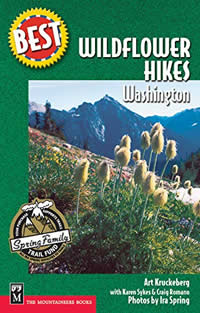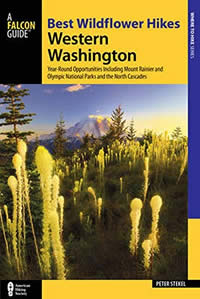![[Pacific Northwest Medicinal Plants] cover](https://depts.washington.edu/hortlib/graphix/PacificNorthwestmedicinalplants400.jpg)
Can plants heal our bodies? Searching for answers to this basic question, Scott Kloos provides a revealing excursion in “Pacific Northwest Medicinal Plants: Identify, Harvest, and Use 120 Wild Herbs for Health and Wellness”, published by Timber Press in 2017. This comprehensive field guide and reference work covers Alaska, British Columbia, Oregon, Washington, and Northern California.
Kloos shares what he has learned from more than two decades of wildcrafting and working with plant medicine. He runs his own school as well as a folk medicine business. In helping people understand traditional uses of medicinal plants, he acknowledges some level of uncertainty and risk involved. Self-treatment is strongly not recommended; consulting a qualified practitioner is advised.
In the book, Kloos first describes basic botanical concepts, tools for harvesting, formulas for making medicine, ethical and sustainable wildcrafting practices, herbal safety, and a breakdown of the harvesting season. Photographs taken by Kloos accompany the plants he profiles. He provides detailed descriptions of each plant: their growth habits, parts of the plant, identifying characteristics, where one is likely to find the plant, the best time of year to harvest, and how to harvest the plant. Medicinal uses of the plant and methods of preparing each part of the plant as medicine are described. Cautionary notes throughout the book alert readers regarding such matters as toxicity, dosage precautions, and uses with other medications or during pregnancy. It is imperative to consider potentially harmful effects of an herb.
For thousands of years, plants have been the chief source of medicine around the world. Healers have prescribed many cures from the flora around them. Nevertheless, there is a lot we don’t know. It is important to let your doctor and other health practitioners know which herbal remedies you are considering taking. Meanwhile, reading this book can help you cultivate a more healthy respect for the wild, bonding with the living world in all it offers us.
Excerpted from the August 2019 Leaflet Volume 6, Issue 8.
![[My Hair is a Garden] cover](https://depts.washington.edu/hortlib/graphix/myhairisagarden.jpg)
![[Elizabeth and Her German Garden] cover](https://depts.washington.edu/hortlib/graphix/ElizabethandherGermangarden.jpg)
![[Say Yes! to Kids with Disabilities] cover](https://depts.washington.edu/hortlib/graphix/sayyes!tokidswithdisabilities.jpg)
 I was surprised to learn that Art Kruckeberg co-authored “Best Wildflower Hikes Washington”, one of his last book publications (2004). His contribution is primarily found in “Art’s Notes,” extra tidbits on the floral treasures of the fifty hikes described.
I was surprised to learn that Art Kruckeberg co-authored “Best Wildflower Hikes Washington”, one of his last book publications (2004). His contribution is primarily found in “Art’s Notes,” extra tidbits on the floral treasures of the fifty hikes described. “Best Wildflower Hikes Western Washington by Peter Stekel is a good choice for the Seattle area native plant fancier. It provides a list of favorite hikes, many in or near our three national parks. Others are for easy, lowland hiking, including trails on the San Juan Islands. Each will take you past areas where wildflowers are prominent in season, or to especially good stands of native trees. A thorough introduction provides guidance on essential things to bring, including equipment such as hiking poles. Other sections help you choose the best trails for children and/or dogs, and even give advice on trail etiquette.
“Best Wildflower Hikes Western Washington by Peter Stekel is a good choice for the Seattle area native plant fancier. It provides a list of favorite hikes, many in or near our three national parks. Others are for easy, lowland hiking, including trails on the San Juan Islands. Each will take you past areas where wildflowers are prominent in season, or to especially good stands of native trees. A thorough introduction provides guidance on essential things to bring, including equipment such as hiking poles. Other sections help you choose the best trails for children and/or dogs, and even give advice on trail etiquette. “Plants of Northern California” by Eva Begley includes non-flowering plants such as conifers and ferns. The scope is essentially north of a line from San Francisco to Sacramento, west of the Sierra Nevada range, and south of the Oregon border.
“Plants of Northern California” by Eva Begley includes non-flowering plants such as conifers and ferns. The scope is essentially north of a line from San Francisco to Sacramento, west of the Sierra Nevada range, and south of the Oregon border. Damian Fagan is a University of Washington graduate in botany who now lives in Oregon. His “Wildflowers of Oregon” introduces 400 of the most common wildflowers from across that state, arranged by colors. The majority of these are herbaceous plants, but trees and shrubs with prominent flowers are included. Most of these range northward into Washington and even British Columbia, making this a useful reference throughout the Pacific Northwest.
Damian Fagan is a University of Washington graduate in botany who now lives in Oregon. His “Wildflowers of Oregon” introduces 400 of the most common wildflowers from across that state, arranged by colors. The majority of these are herbaceous plants, but trees and shrubs with prominent flowers are included. Most of these range northward into Washington and even British Columbia, making this a useful reference throughout the Pacific Northwest. “Native Plants in the Coastal Garden” (1996, revised 2002) by April Pettinger and Brenda Costanzo brings a British Columbia focus to native plant gardening. Essays describe the rise of a late 20th century naturalistic aesthetic in European and American garden design and the supreme suitability of native plants for this look. Many different design aspects are considered, such as container gardening with native plants, and the large role that grasses play in any landscape.
“Native Plants in the Coastal Garden” (1996, revised 2002) by April Pettinger and Brenda Costanzo brings a British Columbia focus to native plant gardening. Essays describe the rise of a late 20th century naturalistic aesthetic in European and American garden design and the supreme suitability of native plants for this look. Many different design aspects are considered, such as container gardening with native plants, and the large role that grasses play in any landscape. Art Kruckeberg (1920-2016) has a legendary reputation for his research and teaching in botany, and his expansion of that work into the natural history and geology of selected ecosystems. But for gardeners, he is best remembered for his classic “Gardening with Native Plants of the Pacific Northwest,” first published in 1982, followed by a second edition in 1996.
Art Kruckeberg (1920-2016) has a legendary reputation for his research and teaching in botany, and his expansion of that work into the natural history and geology of selected ecosystems. But for gardeners, he is best remembered for his classic “Gardening with Native Plants of the Pacific Northwest,” first published in 1982, followed by a second edition in 1996.